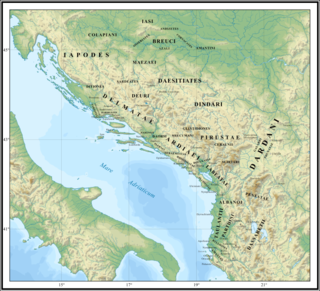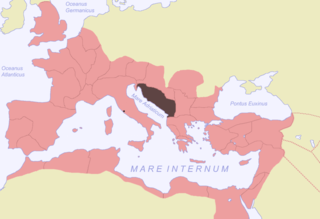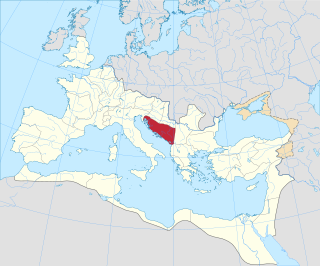Illyria is a historical region in Southeastern Europe, inhabited in antiquity by the Illyrians.
Contents
Illyria may also refer to:
Illyria is a historical region in Southeastern Europe, inhabited in antiquity by the Illyrians.
Illyria may also refer to:

In classical and late antiquity, Illyria was a region in the western part of the Balkan Peninsula inhabited by numerous tribes of people collectively known as the Illyrians.
Illyrian may refer to:
Illyricum may refer to:

The Illyrians were a group of Indo-European-speaking people who inhabited the western Balkan Peninsula in ancient times. They constituted one of the three main Paleo-Balkan populations, along with the Thracians and Greeks.

The Dardani or Dardanians were a Paleo-Balkan people, who lived in a region that was named Dardania after their settlement there. They were among the oldest Balkan peoples, and their society was very complex. The Dardani were the most stable and conservative ethnic element among the peoples of the central Balkans, retaining an enduring presence in the region for several centuries.
Taulantii or Taulantians were an Illyrian people that lived on the Adriatic coast of southern Illyria. They dominated at various times much of the plain between the rivers Drin (Drilon) and Vjosa (Aoös). Their central area was the hinterland of Epidamnos-Dyrrhachion, corresponding to present-day Tirana and the region between the valleys of Mat and Shkumbin (Genusus). The Taulantii are among the oldest attested Illyrian peoples, who established a powerful kingdom in southern Illyria. They are among the peoples who most marked Illyrian history, and thus found their place in the numerous works of historians in classical antiquity.

Illyricum was a Roman province that existed from 27 BC to sometime during the reign of Vespasian. The province comprised Illyria/Dalmatia in the south and Pannonia in the north. Illyria included the area along the east coast of the Adriatic Sea and its inland mountains, eventually being named Dalmatia. Pannonia included the northern plains that now are a part of Serbia, Croatia and Hungary. The area roughly corresponded to part or all of the territories of today's Albania, Kosovo, Montenegro, Serbia, Bosnia and Herzegovina, Croatia, and Slovenia.

Illyro-Roman is a term used in historiography and anthropological studies for the Romanized Illyrians within the ancient Roman provinces of Illyricum, Dalmatia, Moesia, Pannonia and Dardania.
Albanopolis was a city in ancient Roman Macedon specifically in Epirus Nova, the city of the Albanoi, an Illyrian tribe. Albanopolis has been located by various scholars at the modern-day village of Zgërdhesh or at Krujë. The ancient city may correspond with later mentions of the settlement called Arbanon and Albanon during the Middle Ages, although it is not certain this was the same place. The city appears at 150 AD, almost 300 years after Roman conquest of the region.

Dalmatia was a Roman province. Its name is derived from the name of an Illyrian tribe called the Dalmatae, which lived in the central area of the eastern coast of the Adriatic Sea. It encompassed the northern part of present-day Albania, much of Croatia, Bosnia and Herzegovina, Montenegro,and Serbia, thus covering an area significantly larger than the current Croatian and Montenegrin region of Dalmatia. Originally this region was called Illyria or Illyricum.

Praevalitana was a Late Roman province that existed between c. 284 and c. 600. It included parts of present-day Montenegro, Albania, and part of present-day Kosovo. Its capital city was Doclea, later Scodra.
The Parthini, Partini or Partheni were an Illyrian tribe that lived in the inlands of southern Illyria. They likely were located in the Shkumbin valley controlling the important route between the Adriatic Sea and Macedonia, which corresponded to the Via Egnatia of Roman times. Consequently, their neighbours to the west were the Taulantii and to the east the Dassaretii in the region of Lychnidus.
The history of the Illyrians spans from the beginning of the 2nd millennium BC up to the 1st century AD in the region of Illyria and in southern Italy where the Iapygian civilization flourished.
The Illyrian language was an Indo-European language or group of languages spoken by the Illyrians in Southeast Europe during antiquity. The language is unattested with the exception of personal names and placenames. Just enough information can be drawn from these to allow the conclusion that it belonged to the Indo-European language family.
Palaeste or Palaiste was a town in the Ceraunian Mountains, on the Chaonian coast, between the southern Adriatic and the Ionian Sea. The town was placed south of the Akrokeraunian Promontory, the natural boundary that separated Epirus from Illyria in classical antiquity. It was located near modern day Palasë in Albania.
Illyrians may refer to:
Illyrology or Illyrian studies is interdisciplinary academic field which focuses on scientific study of Illyria and Illyrians as a regional and thematic branch of the larger disciplines of ancient history and archaeology. A practitioner of the discipline is called Illyrologist. His duty is to investigate the range of ancient Illyrian history, culture, art, language, heraldry, numizmatic, mythology, economics, ethics, etc. from c. 1000 BC up to the end of Roman rule around the 5th century.

The Culture of ancient Illyria or Illyrian culture begins to be distinguished by increasingly clear features during the Middle Bronze Age and especially at the end of the Late Bronze Age. Ceramics as a typical element is characterized by the extensive use of shapes with two handles protruding from the edge as well as decoration with geometric motifs. At this time the first fortified settlements were established. The local metallurgy produced various types of weapons on the basis of Aegean prototypes with an elaboration of artistic forms. The main tools were the axes of the local types "Dalmato-Albanian" and "Shkodran", as well as the southern type of double ax. Spiritual culture is also expressed by a burial rite with mounds (tumuli) in which a rich material of archaeological artifacts has been found.

Illyrian education is a term in the field of the history of education and pedagogical thought that denotes the totality of forms, organizations and educational institutions in the Illyria and among Illyrians. In the early periods, the education in Illyria and among the Illyrians was under the influence of Greek education, while later it was under the influence of Roman culture. Based on the latest scientific research and discoveries in various aspects of Illyrology: historical, archeological, epigraphic, linguistic, paleographic, etc., it has become possible to better summarize the Illyrian educational system. Illyrian education stretches over a period of time between the 8th century BCE, when the Illyrian culture began to flourish, and the 7th century CE, when the Illyrians are last mentioned in historical sources. In general, it can be said that education among the Illyrians was developed starting from a level of family and informal education towards an organized, institutional, and formal educational system.